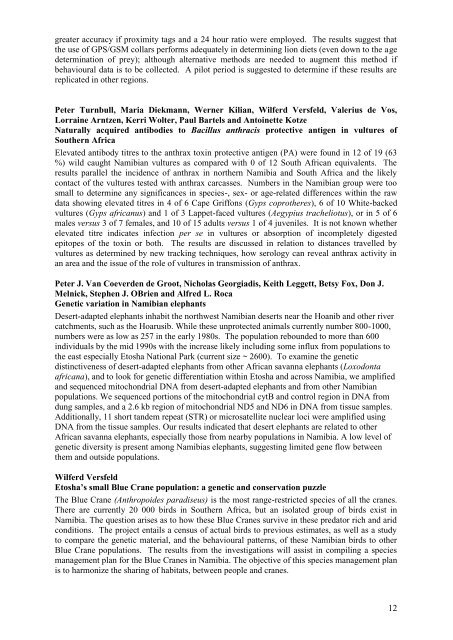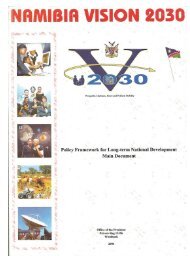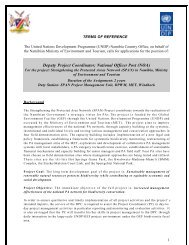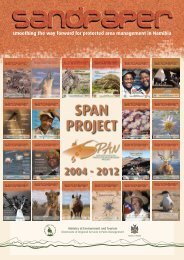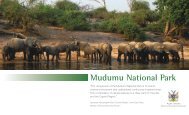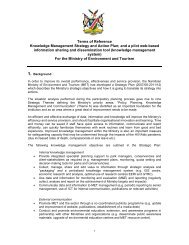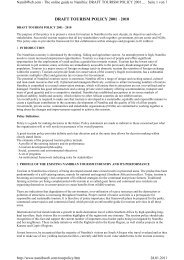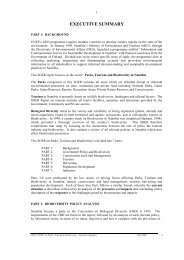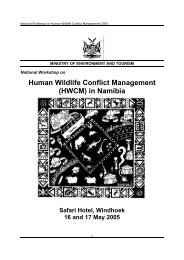Etosha: the Human Footprint - Ministry of Environment and Tourism
Etosha: the Human Footprint - Ministry of Environment and Tourism
Etosha: the Human Footprint - Ministry of Environment and Tourism
Create successful ePaper yourself
Turn your PDF publications into a flip-book with our unique Google optimized e-Paper software.
greater accuracy if proximity tags <strong>and</strong> a 24 hour ratio were employed. The results suggest that<br />
<strong>the</strong> use <strong>of</strong> GPS/GSM collars performs adequately in determining lion diets (even down to <strong>the</strong> age<br />
determination <strong>of</strong> prey); although alternative methods are needed to augment this method if<br />
behavioural data is to be collected. A pilot period is suggested to determine if <strong>the</strong>se results are<br />
replicated in o<strong>the</strong>r regions.<br />
Peter Turnbull, Maria Diekmann, Werner Kilian, Wilferd Versfeld, Valerius de Vos,<br />
Lorraine Arntzen, Kerri Wolter, Paul Bartels <strong>and</strong> Antoinette Kotze<br />
Naturally acquired antibodies to Bacillus anthracis protective antigen in vultures <strong>of</strong><br />
Sou<strong>the</strong>rn Africa<br />
Elevated antibody titres to <strong>the</strong> anthrax toxin protective antigen (PA) were found in 12 <strong>of</strong> 19 (63<br />
%) wild caught Namibian vultures as compared with 0 <strong>of</strong> 12 South African equivalents. The<br />
results parallel <strong>the</strong> incidence <strong>of</strong> anthrax in nor<strong>the</strong>rn Namibia <strong>and</strong> South Africa <strong>and</strong> <strong>the</strong> likely<br />
contact <strong>of</strong> <strong>the</strong> vultures tested with anthrax carcasses. Numbers in <strong>the</strong> Namibian group were too<br />
small to determine any significances in species-, sex- or age-related differences within <strong>the</strong> raw<br />
data showing elevated titres in 4 <strong>of</strong> 6 Cape Griffons (Gyps copro<strong>the</strong>res), 6 <strong>of</strong> 10 White-backed<br />
vultures (Gyps africanus) <strong>and</strong> 1 <strong>of</strong> 3 Lappet-faced vultures (Aegypius tracheliotus), or in 5 <strong>of</strong> 6<br />
males versus 3 <strong>of</strong> 7 females, <strong>and</strong> 10 <strong>of</strong> 15 adults versus 1 <strong>of</strong> 4 juveniles. It is not known whe<strong>the</strong>r<br />
elevated titre indicates infection per se in vultures or absorption <strong>of</strong> incompletely digested<br />
epitopes <strong>of</strong> <strong>the</strong> toxin or both. The results are discussed in relation to distances travelled by<br />
vultures as determined by new tracking techniques, how serology can reveal anthrax activity in<br />
an area <strong>and</strong> <strong>the</strong> issue <strong>of</strong> <strong>the</strong> role <strong>of</strong> vultures in transmission <strong>of</strong> anthrax.<br />
Peter J. Van Coeverden de Groot, Nicholas Georgiadis, Keith Leggett, Betsy Fox, Don J.<br />
Melnick, Stephen J. OBrien <strong>and</strong> Alfred L. Roca<br />
Genetic variation in Namibian elephants<br />
Desert-adapted elephants inhabit <strong>the</strong> northwest Namibian deserts near <strong>the</strong> Hoanib <strong>and</strong> o<strong>the</strong>r river<br />
catchments, such as <strong>the</strong> Hoarusib. While <strong>the</strong>se unprotected animals currently number 800-1000,<br />
numbers were as low as 257 in <strong>the</strong> early 1980s. The population rebounded to more than 600<br />
individuals by <strong>the</strong> mid 1990s with <strong>the</strong> increase likely including some influx from populations to<br />
<strong>the</strong> east especially <strong>Etosha</strong> National Park (current size ~ 2600). To examine <strong>the</strong> genetic<br />
distinctiveness <strong>of</strong> desert-adapted elephants from o<strong>the</strong>r African savanna elephants (Loxodonta<br />
africana), <strong>and</strong> to look for genetic differentiation within <strong>Etosha</strong> <strong>and</strong> across Namibia, we amplified<br />
<strong>and</strong> sequenced mitochondrial DNA from desert-adapted elephants <strong>and</strong> from o<strong>the</strong>r Namibian<br />
populations. We sequenced portions <strong>of</strong> <strong>the</strong> mitochondrial cytB <strong>and</strong> control region in DNA from<br />
dung samples, <strong>and</strong> a 2.6 kb region <strong>of</strong> mitochondrial ND5 <strong>and</strong> ND6 in DNA from tissue samples.<br />
Additionally, 11 short t<strong>and</strong>em repeat (STR) or microsatellite nuclear loci were amplified using<br />
DNA from <strong>the</strong> tissue samples. Our results indicated that desert elephants are related to o<strong>the</strong>r<br />
African savanna elephants, especially those from nearby populations in Namibia. A low level <strong>of</strong><br />
genetic diversity is present among Namibias elephants, suggesting limited gene flow between<br />
<strong>the</strong>m <strong>and</strong> outside populations.<br />
Wilferd Versfeld<br />
<strong>Etosha</strong>’s small Blue Crane population: a genetic <strong>and</strong> conservation puzzle<br />
The Blue Crane (Anthropoides paradiseus) is <strong>the</strong> most range-restricted species <strong>of</strong> all <strong>the</strong> cranes.<br />
There are currently 20 000 birds in Sou<strong>the</strong>rn Africa, but an isolated group <strong>of</strong> birds exist in<br />
Namibia. The question arises as to how <strong>the</strong>se Blue Cranes survive in <strong>the</strong>se predator rich <strong>and</strong> arid<br />
conditions. The project entails a census <strong>of</strong> actual birds to previous estimates, as well as a study<br />
to compare <strong>the</strong> genetic material, <strong>and</strong> <strong>the</strong> behavioural patterns, <strong>of</strong> <strong>the</strong>se Namibian birds to o<strong>the</strong>r<br />
Blue Crane populations. The results from <strong>the</strong> investigations will assist in compiling a species<br />
management plan for <strong>the</strong> Blue Cranes in Namibia. The objective <strong>of</strong> this species management plan<br />
is to harmonize <strong>the</strong> sharing <strong>of</strong> habitats, between people <strong>and</strong> cranes.<br />
12


